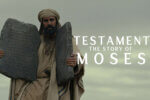No trip to Israel would be complete without a visit to these important sites.
Writing this article involved a dangerous assignment—and it wasn’t because I was traveling throughout Israel to research it. Ten days of travel was nothing compared with the difficulty of choosing just 10 biblical sites to feature among thousands of worthy options in the Holy Land. How could I narrow 6,000 years of history to 10 must-see sites? What should I include? And even more difficult, what should I leave out?
When you visit Israel, you’ll see much more than these 10 sites, of course, but my goal is to give you a taste of the land—and to encourage you to plan now to visit Israel yourself. You will never be the same. Ready to begin your tour?
1. The Western Wall
We start in Jerusalem (pronounced yer-ROO-shah-lie-eem in Hebrew), which David proclaimed the capital of Israel in 996 B.C. Jerusalem’s Old City is divided into quarters—Jewish, Christian, Armenian and Muslim—that mirror its ancient history. Sultan Suleiman the Magnificent built the present walls around the Old City in the 16th century. Few cars can traverse the narrow stone streets, some of which are only a few yards wide, so it’s a great place to walk and enjoy the sights at street-level.
People live, worship, work and dine inside the walls, and you’ll see colorful markets, shops, cafes and tiny residential areas. Twelve gates ring the ancient walls surrounding the city, although some are sealed, including the Eastern Gate. Also called the Beautiful or Golden Gate, this is the gate the Bible says will open to receive the Messiah upon His return.
The centerpiece of the Old City is the Western Wall (Kotel, in Hebrew; sometimes called the Wailing Wall). On this spot Solomon built the first temple.
Nebuchadnezzar destroyed it in 587 B.C., but Nehemiah rebuilt it in 445 B.C.
About 40 years before Jesus was born, Herod expanded and beautified the second temple. In A.D. 70, the Romans destroyed it, and today the only remnant is the retaining wall of the temple’s supporting platform—known as the Western Wall.
The Western Wall is Judaism’s holiest shrine. Its plaza is a large outdoor place of prayer on regular days and holidays. Christians are welcome to pray at the wall, but men must pray at one area while women pray at another. You can write your prayer requests on tiny notes and place them between the stones of the wall. (Before you go in person, watch a live webcam of the wall at thewall.org.)
You can also tour the fascinating ancient underground tunnels along the Western Wall. These include a water shaft, rooms, public halls and other archaeological discoveries (aish.com/seminars/tunneltours).
A large marker at the entrance to the Western Wall recounts the site’s dizzying history, and you’ll probably find yourself overwhelmed by it all. Here Abraham prepared to sacrifice Isaac (Gen. 22:2), David desired to build a house for God (2 Sam. 7:1-17) and Solomon constructed the first temple (1 Kin. 5-6). Here also Isaiah and Jeremiah prophesied (Is. 6:1-8; Jer. 7:1-15) and Ezekiel foresaw the future temple (Ezek. 40; 44).
On this spot Joseph and Mary presented Jesus (Luke 2:22-38). Later, on this same spot, Jesus astonished the rabbis with His teaching (Luke 2:40-47), kicked out the money changers (Matt. 21:12-17) and was tempted by Satan (Luke 4:9-13).
Above the Western Wall is the Temple Mount, holy to Jews, Christians and Muslims—and the planet’s most contested piece of real estate. Two of Islam’s most sacred sites are on the Temple Mount: Al-Aqsa Mosque and the Dome of the Rock, which houses the foundation stone from which Muslims believe the world was established. Muslims also believe that Abraham sacrificed his son here (although they believe it was Ishmael, not Isaac). Is it any wonder that this holiest site for Jews, Christians and Muslims is the scene of so much contention?
2. Garden Tomb
There is some discrepancy about the exact place where Jesus was buried—inside the Old City (at the site of the present-day Church of the Holy Sepulcher) or outside. Most believe it was outside the gates of the Old City at the Garden Tomb. A sign on the tomb says, “He is not here—for He is risen.”
A guide will tell you, “Millions of people come here from all over the world to see absolutely nothing.” The sign and the guide are absolutely right; the tomb is indeed empty, as it has been for 2,000 years.
Just around the corner is Skull Hill, which some believe is the site of the crucifixion. The craggy rocks on the side of the hill bear a striking resemblance to a skull.
Both the Garden Tomb and Skull Hill are on the Mount of Olives. Forty days after Jesus’ resurrection, He ascended to heaven from the top of the Mount of Olives (Luke 24:50; Acts 1:4-12). From the summit you can enjoy a spectacular view of the Old City, particularly in the morning when the sun behind you shines on the white limestone from which every building in Jerusalem is made.
Modern-Day Sites in Israel
1. Yad Vashem: Established by the Holocaust Martyrs’ and Heroes’ Remembrance Authority in memory of the 6 million Jews murdered during World War II (yadvashem.org.il).
2. Israel Museum: Acres of excellent exhibits, including the Shrine of the Book with the Dead Sea Scrolls (www.imj.org.il).
3. Masada: Herod’s spectacular mountain-top palace by the Dead Sea; site of the Jews’ heroic last stand against the Romans in A.D. 73 (parks.org.il).
4. Kibbutz: Collective farms, some more than 70 years old, where early Zionists helped establish modern-day Israel; dozens are still in existence today (www.kibbutz.co.il).
5. Forests: Help replant Israel’s forests by planting a tree (see Lev. 19:23) at centers throughout Israel (kkl.org.il).
6. Tels: Ongoing archaeological excavations uncovering Israel’s history.
7. Knesset: Israeli Parliament in Jerusalem, where visitors with ID may watch parliamentary proceedings (knesset.gov.il).
8. Succat Hallel: Modern-day worship center overlooking Mount Zion that offers 24/7 corporate worship and intercession (jerusalempraise.com).
9. Chagall Windows: Beautiful stained-glass windows of the 12 tribes of Israel; at Jerusalem’s Hadassah-Hebrew University (www.md.huji.ac.il/chagall/chagall.html).
10. Israel Ministry of Tourism: Maps, tours, brochures and other tourist information; inside Jerusalem’s Old City near Jaffa Gate (goisrael.com).
3. Garden of Gethsemane
Jesus spent the night before He was crucified in the Garden of Gethsemane (Matt. 26:30-56). Even today ancient, gnarled olive trees fill the peaceful garden, located on the Mount of Olives. Gethsemane in Greek means “olive-oil press,” and although the press is long gone, the trees remain.
For the many Christians who find it distracting to see a church built on every historic site, the Garden of Gethsemane can be a welcome place of peace and natural beauty. It’s easy to imagine Jesus weeping before His Father in this beautiful setting. It was also here that Judas, leading a crowd armed with swords and clubs, betrayed Jesus (Matt. 26:48).
Beyond Israel
You’ll also find the roots of your faith in Jordan, Egypt, Lebanon, Turkey, Greece and Syria.
Mount Nebo (Jabal Siyagha): After the exodus from Egypt and the 40-year trek through the desert, Moses first surveyed the Promised Land from here (Deut. 34:1-8).
Plains of Moab: Just before entering the Promised Land, the 12 tribes of Israel camped on the Plains of Moab on the east side of the Jordan River opposite Jericho. Here Moses delivered his last messages (the book of Deuteronomy). After his death, the nation remained here for one month to mourn his death. This is also the area where Ruth lived (Ruth 2:6).
Bethany Beyond the Jordan: Many believe that the large loop in the Jordan River opposite Jericho could be the site where John baptized Jesus (John 1:28). It’s also where Jesus fled after being threatened with stoning in Jerusalem (John 10:40). Jesus spent time in this area on His last journey from Galilee to Jerusalem (Matt. 19).
Decapolis: Jesus preached and performed miracles in this “10 cities” region in north Jordan (Matt. 4:25; Mark 5:20), including freeing the demon-possessed young man in Gadara—modern Umm Qais (Matt. 8:28-34).
Egypt
Mount Sinai (also called Mount Horeb): The exact site is not certain, but God spoke with Moses in this area (Ex. 3:1-14). You can hike to the top or take a camel ride. At 7,500 feet, it’s a spectacular place to watch the sun rise. The area includes the well where Moses met his wife Zipporah (Ex. 2:16-21).
Deir al-Muharraq: Tradition says Joseph, Mary and Jesus stopped on the site of this monastery in the town of Nazali on their flight to Egypt (Matt. 2:13-20). Their route would have taken them along the northern part of Egypt, then south along the Nile Valley.
Alexandria: The apostle Mark settled here in the second half of the first century A.D.
Lebanon
Tyre and Sidon: These two cities are not far from each other on the coast
of the Mediterranean. Elijah performed miracles in Sidon (1 Kin. 17:9-24; Luke 4:26). Jesus visited the “coasts” of Tyre and Sidon (Matt. 15:21; Mark 7:24), and many came from these regions to hear Him (Mark 3:8; Luke 6:17). Paul spent a week in Tyre at the end of his third journey (Acts 21:3-7).
Turkey
Antioch (Antakya): This city served as the base for Paul’s missionary journeys. It was where Jesus’ followers were first called “Christians” (Acts 11:26).
Ephesus, Smyrna, Pergamum, Thyatira, Sardis, Philadelphia and Laodicea: These are the locations of the seven churches mentioned in Revelation 2-3.
Tarsus: The birthplace of Paul, you can see the site of his home.
Greece
Corinth, Philippi, Thessaloniki: You can tour many of the cities where Paul wrote his epistles to the believers. He lived in Corinth and visited often, writing two letters to the Christian community here (1 and 2 Corinthians). Paul visited Philippi three times in the A.D. 50s, and Thessaloniki (or Salonika) was also the home of a growing New Testament church.
Athens: Areopagus or Areios Pagos is the “Hill of Ares” or Mars Hill, located northwest of the Acropolis, where Paul told the Athenians about the identity of the “Unknown God” (Acts 17:23).
Patmos: John spent his last years here and had the visions that he wrote in the book of Revelation. You can visit the Cave of the Apocalypse, where he received the revelations (Rev. 1:9).
Syria
Damascus: The “Street Called Straight” is still a bustling thoroughfare in the old city. This is where Saul met Ananias and was baptized, preached and escaped death by being dropped in a basket through a window (see Acts 9:10-25).
4. Via Dolorosa
Winding through the Old City of Jerusalem is the Via Dolorosa, or the Way of Sorrows, a mile-long route that commemorates Jesus’ walk to His crucifixion. Pilgrims have walked this route for 1,000 years. It’s far from the peaceful setting you may have envisioned, and it can be almost surreal to walk down the noisy, narrow lanes—past vendors hawking their wares and kids balancing trays of bread on their heads. Yet this is, in fact, exactly what Jesus would have seen on that final day.
Fourteen stations of the cross mark the route. With a map or guide, you can easily walk it. Some of the stations are on the narrow streets themselves, while others are inside church buildings. Some of the stations mark events in the Bible, but others are based only on tradition. The last stations, marking Jesus’ crucifixion and burial, are inside the dark and ancient Church of the Holy Sepulcher.
5. The Upper Room
A phrase you will hear frequently in Israel is, “This is the traditional site of … .” In many cases no one knows the exact spot at which a biblical event occurred, and many of the sites rely on tradition for their locations.
In addition, buildings that currently exist on sites have been constructed throughout the ages. Some may appear old, but they are not the exact buildings in which events occurred, even though they are constructed on the original sites.
The Upper Room is a good example. Many historians believe it was the site of the Last Supper (Matt. 26:26-35) and Pentecost (Acts 2:1-4). The building itself, however, is a 14th-century re-creation and at one time was even a mosque.
6. Nazareth
If you’re from the United States and accustomed to five-day cross-country car rides, you’ll have to adjust to the distances in Israel. When your guide announces that you’re going to Nazareth, don’t settle back for a long bus drive. Israel is only about the size of New Jersey and 60 miles across, so it doesn’t take long to get from place to place. Nazareth, the town where Jesus spent His boyhood, is about 60 miles north of Jerusalem.
Nazareth Village is a wonderful re-creation of what the town looked like during Jesus’ boyhood, featuring actors dressed in traditional costumes performing ancient crafts (nazarethvillage.com). You can also take a walking tour of the old city and visit the Church of the Annunciation, the Basilica of the Annunciation and the Grotto of the Annunciation, all commemorating the angel Gabriel’s appearance to Mary to announce the birth of Jesus. Mary’s Well is the only spring in Nazareth, and many believe this is where she would have gone to draw water.
7. The Sea of Galilee
The Sea of Galilee is not a sea but rather a small lake fed by the Jordan River. It can be a little confusing because it’s also called Lake Kinneret, the Sea of Tiberias and the Lake of Gennesaret. Almost 700 feet below sea level, it’s known for violent storms that can occur without warning. Here Jesus rebuked the winds and sea (Matt. 8:26), taught from Peter’s boat (Mark 3:7-9), multiplied loaves and fishes (Luke 5:1-11) and walked on water (Matt. 14:22-23).
»Tiberias is the largest city on the lake, and you’ll find it a delightful place that mixes old and new. You can visit the Galilee Experience for a multimedia show about the area’s ancient history and enjoy dinner at one of the many open-air restaurants along the shore. Needless to say, most of them specialize in wonderful locally caught fish.
Moving clockwise from Tiberias around the Sea of Galilee, you can visit many of the places where Jesus ministered:
»Magdala (known today as Migdal), the home of Mary Magdalene (Luke 8:1-2)
»Tabhga, where Jesus multiplied the loaves and fishes (Mark 6:34-44) and later appeared to the disciples after His resurrection (John 21)
»Capernaum, the center of Jesus’ Galilee ministry. He lived here for a substantial period of time, healing the sick, preaching in the synagogue and performing miracles (Matt. 9:1; 4:13).
»Mount of Beatitudes, where Jesus delivered His Sermon on the Mount (Matt. 5:1-8). The hollow in the hill serves as a natural amphitheater to magnify the speaker’s voice.
»Bethsaida, the home of Peter, Philip and Andrew, and the town where Jesus healed the blind man (Mark 8:22)
»Jordan River, where John baptized Jesus (Mark 1:9-11). The Jordan enters the Sea of Galilee at the northern shore and exits to the south, where it flows into the Dead Sea. Today many Christian tour groups include baptisms in the Jordan at Kibbutz Kinneret (Yardenit), near the place where the Jordan flows south out of the Sea of Galilee (yardenit.com).
»Kursi, where Jesus sent demons from the oppressed man into pigs that plunged into the sea (Luke 8:26-33).
8. The Dead Sea
You can’t leave Israel without a visit to the Dead Sea, less than 15 miles from Jericho. This is the lowest spot on the earth—1,365 feet below sea level—and you can spend a day relaxing here. You can enjoy the natural mineral hot pools, covering yourself with the therapeutic mineral-rich mud, or swim in the water, whose high salt content makes it easy to float.
The beautiful oasis of En Gedi is mentioned in Song of Solomon 1:14 and houses the caves where David hid from Saul (1 Sam. 24:1-22). The lush landscape, complete with sparkling waterfall, offers a striking contrast to the surrounding desert with its moonlike appearance. A good time to visit En Gedi is in the autumn for the annual Feast of Tabernacles celebration icej.org/articles/feast_of_tabernacles).
On the western shore of the Dead Sea is Qumran. Here in 1947 Bedouin shepherd boys discovered clay jars containing the Dead Sea Scrolls, hundreds of parchment fragments of books of the Old Testament (deadsea.co.il). The scrolls themselves are housed in Jerusalem at the Israel Museum (www.imj.org.il).
The stunning Negev Desert lies southwest of the Dead Sea. You can tour Avdat and learn about ancient biblical caravan routes that brought spices and incense from Asia, across the desert, and north to the Mediterranean ports or by camel on to Europe. You can also visit Bedouin encampments that have not changed much since the time of Abraham and take a camel ride through the desert.
The Negev is the place where the children of Israel wandered in the Wilderness of Zin during the Exodus (Ex. 3:1-15) and where Moses met with God on Mount Sinai (Ex. 19:1,20-22) to receive the Law (Deut. 6).
Beersheba is considered the capital of the Negev. Abraham founded it 3,800 years ago and dug wells here. God also appeared here to Hagar, Isaac, Jacob and Elijah. Today it’s a thriving city with a large university.
9. Bethlehem
Located on the ancient caravan route, Bethlehem was, of course, Jesus’ birthplace (Matt. 2:1). It was also the place where Rachel died giving birth to Benjamin (Gen. 35:18-19; 48:7), where Ruth and Boaz fell in love (Ruth 1:19), where David was born and where Samuel anointed him (1 Sam. 16:1). Just south of Bethlehem are the Pools of Solomon that have provided water for Jerusalem for 3,000 years.
Don’t expect to find in Bethlehem a tiny manger untouched by tourism. No one knows exactly where the manger stood, but that doesn’t mean there’s not a church on every possible site. Your tour may include visits to some of them, including the Church of the Nativity and the Chapel of the Milk Grotto. You can also see Shepherds’ Field, where the angels chose to announce the birth of the King of kings to the most unlikely audience (Luke 2:8-20).
10. Joppa/Caesarea
This area just south of modern-day Tel Aviv is mentioned throughout the Old and New Testaments. Joppa, or Jaffa, was the main port of Judea during biblical times. This is the place from which Jonah reluctantly set sail for Tarshish (Jon. 1:3-17).
The picturesque town surrounding the harbor was home to Simon the tanner (with whom Peter stayed) and Tabitha, whom God raised from the dead in response to Peter’s prayers. For thousands of years—until the advent of good roads and modern-day airports—Christians arrived at this port to begin their pilgrimages to the Holy Land.
North of Joppa is Caesarea, the city that Herod the Great built. It was home to Pontius Pilate—and 100,000 other people. Here Peter baptized the centurion Cornelius, the first gentile convert, and here Paul was imprisoned for two years until he was sent to Rome for trial.
Today it is one of 61 national parks and nature reserves in Israel (parks.org.il). You can tour the excavations and see a well-done multimedia presentation, Caesarea Harbor, describing the amazing technology that once existed here, including an amphitheater, aqueduct, theater, hippodrome and huge artificial harbor. There’s also an underwater archaeological park for divers (caesarea.org.il).
These are just 10 of Israel’s many wonderful and inspiring biblical sites. Perhaps you’ve longed to go to Israel. Or maybe you’ve never considered a visit, but God is stirring something in your heart.
Israel is one of the most tourist-friendly places on earth. Even if you’ve never been overseas before, you can make this trip without a problem. Christian tour groups of all denominations and interests have well-organized tours all year long. If you don’t feel comfortable venturing off on your own, a tour is an excellent way to see Israel for the first (or 10th) time.
Many Christians are concerned about how safe it is to visit Israel. That has been a concern for 2,000 years, and you will have to ask the Lord when you should go. But do not let fear make the decision for you.
No one who has gone to Israel has ever regretted the trip—the time expended, the money spent or the faith it took to go. You will not regret going, but you may always regret not going.
Why not step out in faith and begin planning a trip? This is the time to go. This is your time to go. Israel is waiting for you. You will never be the same.
Diana Scimone is a journalist and president of PawPaw’s Pals Inc., a nonprofit organization that helps children in crisis situations around the world (pawpawspals.org).
For additional information that will help you plan a memorable trip to Israel, log on to charismamag.com /travel.






Leave a Comment
You must be logged in to post a comment.